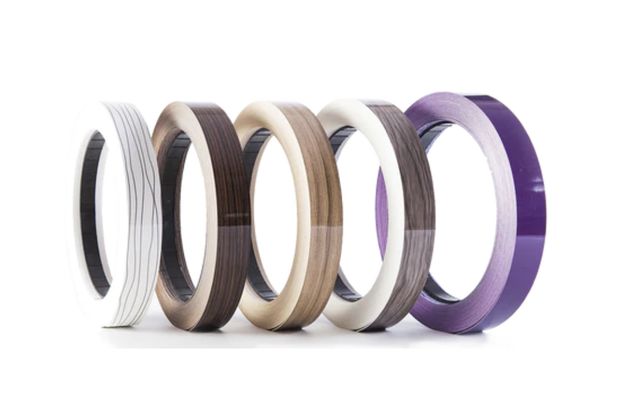Choosing Between Veneer and PVC Edgebanding: A Guide for Cabinetmakers and DIYers
- Category: Pics |
- 7 Nov, 2024 |
- Views: 402 |

Choosing Between Veneer and PVC Edgebanding: A Guide for Cabinetmakers and DIYers
Edgebanding is an essential finishing touch for furniture and cabinetry, protecting the edges of surfaces while enhancing their aesthetic appeal. For those deciding between veneer and PVC edgebanding, the choice can feel challenging, as each offers distinct advantages and limitations. In this guide, we’ll explore the key factors to consider to help cabinetmakers and DIY enthusiasts make an informed decision suited to their unique project needs.
1. Material Composition and Visual Appeal
One of the most notable differences between veneer and PVC edgebanding lies in their material composition, which directly affects their appearance.
• Veneer Edgebanding: Made from thin slices of real wood, veneer edgebanding offers a natural look and texture that is difficult to replicate. This option is ideal for projects that require a high-end, authentic wood finish. It can be stained, polished, and matched to the wood grain of the furniture, creating a seamless appearance that complements wood-based materials.
• PVC Edgebanding: In contrast, PVC (Polyvinyl Chloride) edgebanding is a synthetic material that can mimic wood but is also available in a wide array of colors, textures, and patterns beyond wood grains. With PVC, you can achieve high-gloss, matte, or even stone-like finishes, making it a versatile choice for modern or industrial aesthetics.
Best For: Choose veneer if a warm, natural look is essential to your design. Opt for PVC if you need a more diverse range of colors or finishes, or if the piece has a contemporary style.
2. Durability and Resistance
Both types of edgebanding offer durability, but each excels under different conditions.
• Veneer Edgebanding: While beautiful, veneer is more susceptible to wear and tear compared to synthetic materials. It can be prone to chipping and may not withstand moisture well if unsealed, making it less ideal for high-moisture environments like bathrooms or kitchens without proper sealing.
• PVC Edgebanding: PVC is highly durable and designed to resist scratches, impact, and moisture. It’s a preferred choice for high-traffic areas and places where furniture edges need to withstand regular use. Newer innovations in PVC also include scratch-resistant coatings, making it even more resilient in demanding environments.
Best For: Choose veneer for projects where the furniture will experience minimal wear, such as decorative cabinets or home office furniture. PVC is ideal for kitchens, bathrooms, or commercial spaces where durability is critical.
3. Ease of Application
The application process is a significant factor for both professional cabinetmakers and DIYers.
• Veneer Edgebanding: Typically applied with contact cement or iron-on adhesive, veneer edgebanding can require some skill, as the material is more fragile and may crack or split if not handled carefully. Veneer can be sanded and finished for a smooth look, but it may take additional time and attention to achieve a flawless result.
• PVC Edgebanding: PVC is generally easier to work with, especially for DIYers, as it is often applied using a hot-melt adhesive, creating a quick and firm bond. For cabinetmakers with access to advanced tools, hot-air or laser edgebanding machines can create seamless applications without visible glue lines, speeding up the process and ensuring a durable bond
Best For: Choose veneer if you have the time and skill to achieve a polished, natural finish. PVC is recommended for DIYers or cabinetmakers needing an efficient, straightforward application process.
4. Environmental Impact
Sustainability is an increasingly important consideration for consumers and professionals alike.
• Veneer Edgebanding: Since veneer is a natural wood product, it is often seen as a more environmentally friendly choice, especially if sourced from sustainably managed forests. However, adhesives and finishes used on veneer can contribute to its environmental footprint, so using low-VOC options is recommended.
• PVC Edgebanding: PVC, being a plastic product, is less eco-friendly than natural wood veneer. However, manufacturers are now offering recycled PVC edgebanding options, and advancements have made it possible to create low-VOC PVC products to reduce indoor air pollution. Additionally, PVC’s long-lasting nature may reduce the need for frequent replacements, lowering its overall environmental impact.
Best For: Choose veneer if sustainability is a top priority, especially if you can source FSC-certified materials. PVC can still be a viable option if you select recycled or low-VOC varieties.
5. Cost Comparison
Budget is a crucial consideration, particularly for larger projects.
• Veneer Edgebanding: Due to its natural composition and often more labor-intensive application, veneer edgebanding tends to be more expensive than PVC. Costs can vary depending on the type of wood, with exotic wood species commanding higher prices.
• PVC Edgebanding: PVC is generally more budget-friendly, making it a go-to choice for projects where cost savings are important. It’s also more widely available in a range of styles and thicknesses, allowing for flexibility in meeting specific project budgets.
Best For: Choose veneer if the project budget allows for a higher investment in materials. PVC is a great option for cost-conscious projects that still require durability and aesthetic flexibility.
6. Maintenance and Longevity
Both edgebanding types offer unique maintenance requirements and longevity factors.
• Veneer Edgebanding: Veneer requires regular care, including dusting and polishing, to maintain its natural appearance. It can be refinished to restore its look over time, but it may also need touch-ups, especially in high-traffic areas.
• PVC Edgebanding: PVC is low-maintenance, resistant to stains, and easy to clean with basic household cleaners. It does not require refinishing and can retain its appearance over the years with minimal upkeep, making it a practical choice for spaces that need durability with minimal maintenance.
Best For: Choose veneer if you’re prepared to invest in occasional maintenance. PVC is ideal for those seeking a low-maintenance, long-lasting solution.
Final Thoughts: Making the Right Choice
Choosing between veneer and PVC edgebanding ultimately depends on the specific needs of your project. Here’s a quick recap to guide your decision:
• Choose Veneer Edgebanding for a classic, natural look in low-moisture environments where an authentic wood appearance is essential, and if you’re comfortable with a little extra maintenance and budget flexibility.
• Choose PVC Edgebanding for durability, cost-effectiveness, and design flexibility in high-traffic or high-moisture areas where longevity and low maintenance are key.
Whether you’re a professional cabinetmaker looking to achieve a refined finish or a DIY enthusiast wanting an easy-to-apply option, both veneer and PVC edgebanding offer valuable benefits. Understanding these distinctions will help you make an informed decision that meets your aesthetic and functional goals, resulting in a polished, professional final product.

